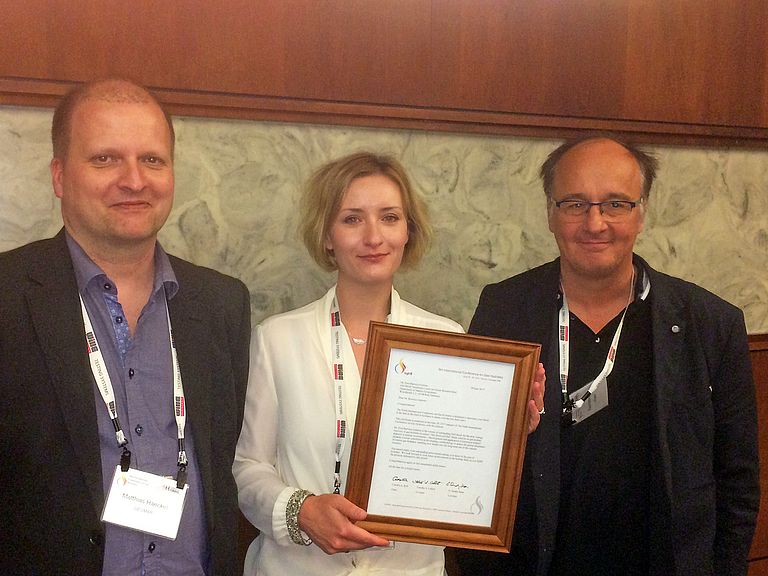Gas hydrate younger than previously thought
GEOMAR researcher awarded for complex computer models of the seafloor
Until 50 years ago, they were considered a curiosity in the laboratory and a nuisance in gas pipelines of the Arctic. Today, we know that large amounts of gas hydrates are harboured in the continental slopes of all oceans. The ice-like compounds of water and gas form at low temperatures and high pressures. Since they primarily contain the combustible gas methane, they are also referred to as “burning ice” and are considered a potential energy resource.
However, for resource purposes gas hydrates have been investigated only for the past 20 years and many details about their origin and occurrence are still unknown. Dr. Ewa Burwicz-Galerne from GEOMAR Helmholtz Center for Ocean Research Kiel has addressed some of these questions within the framework of her PhD thesis. For this purpose she used computer models simulating the formation of gas hydrates and related processes in marine sediments. For this work she received an award for the best thesis in the field of natural-gas-hydrate research at the Ninth International Gas Hydrate Conference (ICGH9) in Denver (Colorado, USA). “This is a great honour, since the recognition comes directly from the gas hydrate community and the conference takes place only every three years” said Dr. Burwicz-Galerne after the ceremony.
In her most recent study published in the international scientific journal Geochemistry Geophysics, Geosystems, Burwicz-Galerne investigates the present-day and the past gas hydrate deposits of the Green Canyon in the Gulf of Mexico using a numerical model developed in the SUGAR project (Submarine Gas Hydrate Reservoirs). She reconstructed the entire development of the seabed in the Green Canyon down to 15 kilometers below the seafloor during the past 210 million years. “This is probably the most complex numerical model of a natural gas hydrate system currently available” says her supervisor and coauthor of the study, Prof. Klaus Wallmann from GEOMAR.
The model which ran on servers in GEOMAR's data center needed around one month of computing time to simulate the evolution of the gas hydrate deposits in the Green Canyon. “In the beginning, we calculated this development solely on the basis of physical rules. We also used paleo-climate and oceanographic data. In the end, we matched the results with data from a few existing cores from the Green Canyon and found that the model is very consistent with observations in the field,” explains Dr. Burwicz-Galerne.
One of the most surprising results was that the gas hydrate accumulations are much younger than previously thought. “Apparently, a constant methane gas recycling takes place at the lower boundary of the gas hydrate layers. The majority of today's hydrate deposits at this location have only been formed in the past 500,000 years,” says the geologist. This finding can also be transferred to other gas hydrate deposits worldwide and thus expand our knowledge on their dynamics.
The results of the study and Dr. Burwicz-Galerne's doctoral thesis in general are now helping to examine the gas hydrates in the Gulf of Mexico in more detail. "Several scientific drilling campaigns are planned. Thanks to the new models, they can be prepared much more precisely,” says Professor Lars Rüpke, the supervisor of the PhD study.
Reference:
Burwicz, E., T. Reichel, K. Wallmann, W. Rottke, M. Haeckel, and C. Hensen (2017): 3-D basin-scale reconstruction of natural gas hydrate system of the Green Canyon, Gulf of Mexico, Geochem. Geophys. Geosyst., 18, 1959–1985, http://dx.doi.org/10.1002/2017GC006876.
Please note:
The Green-Canyon study was supported by the joint academia-industry project PetroHydrate led by Dr. Christian Hensen at GEOMAR.
Contact:
Jan Steffen (GEOMAR, Communication & Media), Tel.: (+49) 0431 600-2811, presse(at)geomar.de





